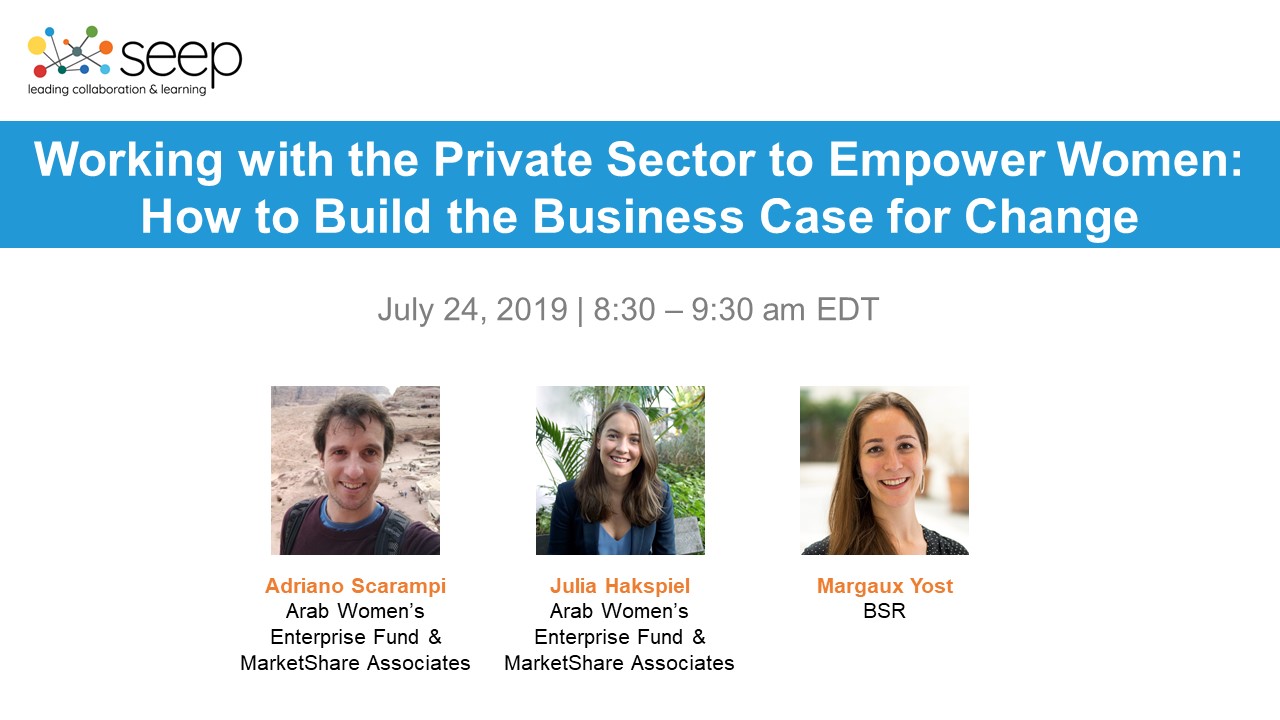Working with the Private Sector to Empower Women: How YOU Can Build a Business Case for Change
Image

This post was originally published on the SEEP blog and was authored by Julia Hakspiel, Arab Women's Enterprise Fund & MarketShare Associates.
The private sector is an essential partner in advancing the process of women’s economic empowerment. By adopting business practices that include and support women as workers, consumers, producers and suppliers, firms can not only contribute towards women’s economic empowerment, but also expand their own market, achieve greater business efficiency, and improve their bottom line. A business case can help firms understand why women’s inclusion and empowerment is important for their mission and values, business model and stakeholders. These benefits can be financial (for example, represented by revenue growth or cost savings), but they can also be non-financial (for example, brand or community reputation).
So how do you begin to build a business case? The process map shown in Figure 1 provides a simplified overview of the steps traditionally undertaken, drawing on the experience of the DFID-funded Arab Women’s Enterprise Fund and case studies from other MSD programs included in our latest Practitioner Learning Brief. This process is naturally iterative and undertaken in close partnership with the partner firm as part of co-creation.

- Select a business case framework. Several factors will influence which framework practitioners might choose, including cost, availability of data, level of complexity needed, and business as well as donor/investor interests in the business case. A simple before and after comparison of key business indicators might be sufficient to evaluate the success of a women-oriented marketing campaign. On the other hand, a more substantial investment such as setting up a childcare facility might require a more thorough analysis of the return on investment. Section 1 of our Brief provides an overview of the most common frameworks used, but ultimately it is up to practitioners to decide which type of analysis will best suit the needs of both the program/organization and the partner firm. The key here is to choose a case that will be persuasive and speaks to the business model and interests of those who will be at the receiving end of the pitch.
- Select key business indicators for tracking. The next step for a practitioner is to work with the private sector partner to identify business performance indicators that are the most relevant, that will resonate with the firm and best demonstrate the business impact of the planned WEE intervention. These will vary depending upon whether the firm is interested in working with women as consumers, workers, suppliers or producers, the type of industry and even the size of the business. For example, the financial services sector uses a number of metrics such as size of their loans, savings balance, arrears rate and portfolio-at-risk (PAR) to evaluate their loan portfolio quality that can be captured as part of a business case. Section 2 of our Brief provides more guidance on different types of business indicators that could be selected.
- Determine data collection requirements. Data collection requirements will depend on the business case framework and indicators selected. A more complex cost-benefit analysis requires data collection before and after the intervention, but also data on the cost of intervention and data to support the economic valuation of indicators.
- Agree on cost and data sharing arrangements. Ideally, the business case should rely as much as possible on existing data that is routinely collected by the firm. If additional data collection is required, cost-sharing with the firm may need to be considered. If the missing data could improve the firm’s long-term performance, for example by establishing a sex-disaggregated customer relationship management (CRM) system, it may be tactical to support the firm to improve or modernize its own data collection systems. The data required for calculating many of these metrics is often confidential and highly sensitive. It is important to have an open discussion with the private sector partner about what results and data can be shared and with whom.
- Collect and analyze data. Data collection should be undertaken hand-in-hand with the partner. This will give them ownership of the process and help embed it more firmly within the organization. While it is important to select quantifiable metrics, qualitative ‘soft’ data often needs to be collected to inform the ‘hard’ data analysis. For example, there may be a local or a very specific explanation for why a business experienced spikes in absenteeism or sales at key points during the year - these should be factored into the business case analysis as outliers or unexpected outcomes. This requires a sound understanding of the nature of the business and soft analysis will be critical in closing consultation with the firm.
- Present data to firm and other market actors. Consider how you want to present and “sell” the data and business case to private sector partners. This links to understanding the culture of the business, their business model and incentives and “speaking” to the private sector using commercial language and data that resonates with their business interests. Firms are most likely to be receptive to just 1-3 key data points presented in a visual infographic or brief case study. In addition to hard data, qualitative information in the form of case studies, testimonials, and interviews can be equally important. It is also important to help firms pitch and disseminate the business case internally. The pitch may need to vary according to who you are selling the business case to – Executive/Senior Management, HR, Procurement, Operations and PR/Communications will each have different primary interests but you may need all of them to buy in for approval of your business case. BSR has developed a helpful guide on honing your business case pitch with different internal business audiences.
- Inform strategic business decisions. It’s critical to keep the big picture in mind when developing the business case and pitch. The aim of business case development is to help decision-makers understand potential business costs and benefits. You need to convince them that taking action to invest in a new approach or business practice is justified commercially as well as providing benefits for women. It has to be a “win-win”. A compelling business case for WEE will also provide a practical set of recommendations on how to implement the approach and how women's empowerment as consumers, producers or employees will enhance their business and reputation.
Webinar Recording
At AWEF, over the past four years, we have learned that there is no blueprint or right way to make the business case for women’s economic empowerment. The approach must be pragmatic, relevant and tailored to the country context, constraints facing women, the sector in question and the specific interests of private sector partners.

Listen to our collaborative webinar with BSR’s HERProject where we discussed in more detail practical approaches for engaging the private sector in more gender-inclusive business practices.
Julia Hakspiel is the Learning Coordinator for AWEF and Managing Consultant with MarketShare Associates, a member of the AWEF consortium. She is also the co-facilitator of Women’s Economic Empowerment Working Group at SEEP and is the author of the new publication, Working with the Private Sector to Empower Women: What to Measure and How to Build the Business Case for Change.

